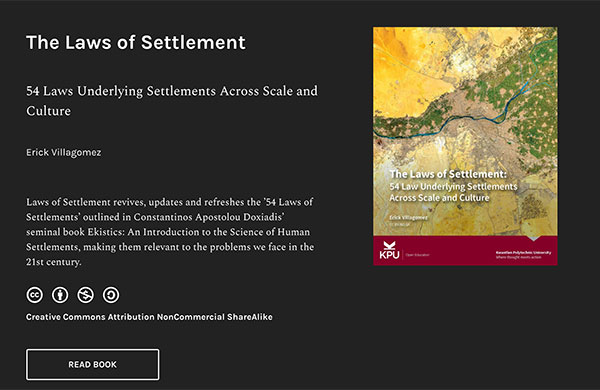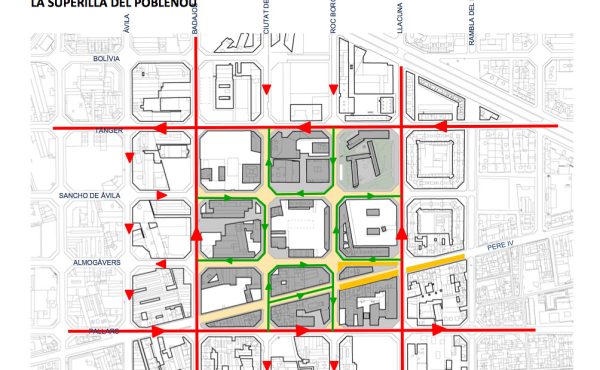
Are there fundamental laws that govern all settlements—from the smallest village to the largest cities? This is the question that drove me to write The Laws of Settlements and continues to propel my research on landscape—a term that I use to describe the complex and continuous dialogue between people and non-human natural systems. It was a question that I thought—and continue to believe—belongs to everybody: one whose answer is necessary to even attempt to engage the complex challenges that will face us for decades to come.
As such, I always intended to make The Laws of Settlements as accessible as possible to the widest possible audience. Not only did this greatly influence the language in the book, but also led me to self-publish the book, in order to keep the cost as low as possible for interested readers. But this was not enough…I wanted to find a way to make it free.
So, it’s with the greatest utmost joy that—after many months of working with the amazing people at Kwantlen Polytechnic University’s Pressbooks to adapt the layered structure of the book into digital form—The Laws of Settlements is available to read for free online!
I ultimately see the text as a living document that I can continue to adapt and add to. Plans are already under works for more chapters, in fact. But in the meantime, feel free to dive in at your leisure. For those who want to learn more about it, below is the Introduction to the book. Enjoy!
*****
INTRODUCTION
This book outlines the laws underlying human settlements of all sizes and across all cultures. Within this context, a “settlement” refers to the physical container created to house human activities, one that interacts with the natural environment and artificial constructs over time. Settlements also exist across scales, spanning the smallest group of buildings to the vast cities we see today. This is particularly relevant now, as written works focus on ‘urban’ landscapes, neglecting to recognize that cities are just one of the many possible stages of human settlements.
My position is straightforward: I believe that, in order to truly understand cities, one must understand the repetitive framework inherent to settlements across scales and developmental stages. To give a physiological analogy, adulthood cannot be truly appreciated without understanding childhood and adolescence. Similarly, cities cannot be well understood without comprehending other settlements such as towns and villages. Furthermore, like human developmental divisions, settlement ‘categories’ are ambiguous. When does a village become a town? Or a town become a city? At a very basic level, this makes understanding a wider range of settlements critical.
What makes understanding settlements more significant is that, unlike humans, they can pass through different stages indefinitely. That is, their development is not linear from birth to death. Cities can transform to towns and villages as easily as villages and towns can change to cities. This, in theory, can occur in perpetuity. The many Roman cities that transformed into smaller settlements following the fall of the Empire, and subsequently transformed into contemporary global cities, demonstrate this process. This being the case, we would be negligent in focusing too much on any single phase of settlement development—cities and villages, alike—without recognizing their attributes as part of a larger continuum.
Given the breadth required to engage settlements as a whole, comprehensive studies on the subject are few and far between. This is where the work of Constantinos Doxiadis comes in.
Constantinos Doxiadis and The Laws of Settlements
The 1960s and 70s were critical for research related to settlements. The reasons for this are varied and complex, but these decades put forth many seminal works in settlement studies. A small sampling will serve to demonstrate the unquestionable richness of this era. Consider Lewis Mumford’s influential The City in History: Its Origins, Its Transformations, and Its Prospects (1961), that described the development of cities in response to the natural environment and the “urban drama” of its inhabitants. His sentiments resonate with Jane Jacobs’ Death and Life of Great American Cities (1961), that challenged the established modern planning regime and described the subtleties of how cities work ‘on the ground’ as a living network of human relationships. A year prior, the influential Image of the City by Kevin Lynch (1960) clarified how people perceive the built environment through mental maps. Any urbanist of merit would also mention the incredibly ambitious A Pattern Language (1977) by Christopher Alexander and Company from Berkley’s Centre for Environmental Structure—that put forth 253 ‘timeless’ patterns that cut across scale and culture—as well as Rem Koolhaas’ now-mythical Delirious New York: A Retroactive Manifesto for Manhattan (1978), the critical social and architectural analysis of New York that radically altered the architecture and urban design professions, and whose influence continues to this day.
These works alone are enough to warrant labeling those decades as a golden age of insights around human settlements, but I beg your indulgence by adding a few more for good measure: Aldo Rossi’s The Architecture of the City (1966), Robert Venturi and Denise Scott Brown’s Learning from Las Vegas (1972), Edward T. Hall’s The Hidden Dimension (1966), and Gordon Cullen’s Townscape (1961), Jan Gehl’s Life Between Buildings (1971), Henri Lefebvre’s sharp The Production of Space (1974), and Oscar Newman’s Defensible Space (1972). Each of these continues to be extremely influential in their respective fields.
Needless to say, this was an extraordinary time…..and among these icons, one must place Greek architect and planner, Constantinos Apostolou Doxiadis. Best known for his planning of Islamabad, Pakistan, his life was sadly cut short in 1975 by Lou Gehrig’s disease at the age of 62. At the height of his popularity, his face blessed the cover of Time Magazine, with work spanning 40 countries. A prolific writer, the last decade of his life saw Doxiadis author no less than 7 comprehensive books, as well as various journal articles, that shared his research findings on settlements: research based on cutting edge computer technologies of the time.
He was a pioneer; the first to propose a science of human settlements founded on his theory of “ekistics”. This urge towards formalizing a science of settlements continues today in the works of those such as Michael Batty (The New Science of Cities, 2013) and Serge Salat (Cities and Forms: On Sustainable Urbanism, 2012). Curiously, despite his significant contributions to the understanding of settlements, his name and work faded into obscurity after his passing.
Of particular relevance here is Doxiadis’ 1968 book, named after the discipline he founded—Ekistics: An Introduction to the Science of Human Settlements. It was written in response to the increasing complexity and growth of settlements at that time, and within it, he lays the framework for his work and research. A colossal undertaking, the book required an interdisciplinary and scalar approach, drawing on knowledge from diverse but related fields—such as archeology, geography, ecology and urban planning—and applying it to the understanding of not only cities but human settlements as a whole—from towns and villages to cities and megacities.
The book, itself—a dense 527-page tome aimed at an academic audience—is one of the first attempts at a rigorously integrated and comprehensive approach to settlements and their associated patterns. And hidden within, with a scant 28 pages dedicated to it, are “54 Ekistic Laws of Settlements”. Intentionally simple—explained by only a handful of sentences—their complexity lay in the fact that they cross-referenced one another, creating an intricate and layered understanding of settlements: a very contemporary approach towards the built environment. In keeping with Doxiadis’ ‘ekistic’ approach, the laws applied to all settlements across time and scale and had ‘indisputable’ validity based on his exhaustive research.
It was almost a decade and a half ago, at the early stages of my professional and professorial career focusing on settlement patterns, that I was first introduced to this book. I remember the moment vividly: upon discussing the challenge of defining the similarities of settlements across time and culture, a senior colleague—one that would eventually be the closest I ever had to a mentor—casually stated that Doxiadis “pretty much ‘figured it out’ decades ago.” Having never heard of his name before then, I immediately purchased a used copy of Ekistics and made my way through the dauntingly large book.
The book is dry and often opaque—much different than the popular titles of Jacobs, Alexander, Lynch and the others that became so influential—but this is outweighed by moments of brilliance and lucid insight. Ekistics was, in many ways, ahead of its time and I implicitly and explicitly refer to its many lessons to this day. But the “54 Laws” have resonated long since I finished reading about them.
Maybe it was the sheer audacity of the claim that ‘indisputable’ laws governing all settlements could be known, but many questions followed: was this the ultimate act of recklessness or bravery? Complete naivety or utter genius? If these were the equivalent of finding the DNA of settlements, why were they treated as a trivial aside in his book, with minimal explanation? The Laws seemed to leave more questions than answers…..with one that particularly nagged at me: After decades of research advances in the field, radical urbanization, and technological advancement, were Doxiadis’ “54 Laws of Settlements” still relevant today?
At that point in my career, I was not in the position to say. But from that time on, I used the Laws as an approach to researching and understanding the underlying framework of settlements from around the world. Many individual studies and classes I held over the past decade put them to the test, and amazingly, most have proven exceedingly resilient.
Now, after over a decade of practice, research and teaching focused on settlements big and small, as we all grapple to find solutions to the creation of human settlements across the globe, I believe it is the right time to revive and refresh Doxiadis’ “54 Laws”.
Simply put: The Laws of Settlements outlines Doxiadis’ original 54 laws, explaining and updating them in light of the vast amount of accumulated knowledge gained since their original publication. With the addition of nuances when necessary, the underlying motivation is to translate them for the 21st century.
This Book – Audience and Organization
Within Ekistics, Doxiadis was adamant about the need for research on human settlements to be made accessible to the public. He was well aware that changes in human settlements had a direct connection to the values of its inhabitants. As such, The Laws of Settlements is written to act as a shared resource to facilitate the meaningful interaction between top-down and bottom-up parties who design, shape and plan human settlements. It is also written for students of urban planning, urban design, architecture and landscape architecture.
Doxiadis’ original approach of having laws that are individually simple and cross-referenced has been maintained. This is supplemented, however, with the inclusion of various easy-to-relate-to precedents, as well as explicit references to seminal works, past and present, outside of Doxiadis’ research. This is where readers can dig more deeply into the subject in question, if desired.
Aside from the differences around referencing, and in recognition of the strength of the initial work by Doxiadis, I have stayed true to his expectations. He states that the laws should be “true, helpful, general, and simple” and my revisions maintain the same focus. All amendments are clearly stated.
I also stay true to the format published in Ekistics—stating each Law, followed by a succinct description of a few of paragraphs. As mentioned above, these are supplemented with further readings, with the explicit intention of giving readers a starting point to investigate the subject discussed.
A few words about numbering. In keeping with the book’s content, each Law is numbered. In the words of Doxiadis: “…not because I consider that this is necessarily their order—although a reasonable order has been attempted—but mainly in order to introduce a proper system of reference.”
There is one exception, however. The Overarching Law – Law 0 is an addition to the original 54. It effectively summarizes the principal idea of Ekistics: more specifically, that human settlements are scalar and co-dependent. This served as a basis for his 54 Laws, and was comprehensively explained in the few hundred pages leading up to them. As such, it requires inclusion right at the outset.
With respect to organizational structure, Doxiadis divided his laws into three sections that are also maintained here: the first, called The Laws of Development, deal with the life-cycle of human settlements—how they ”are born, develop and die”. It is divided into subsections on Creation, Development and Extinction, accordingly.
The second section—titled Laws of Internal Balance—deals with how settlements achieve balance internally, in order to survive. The Laws of Physical Characteristic, the third and final section, deals with more concrete issues and is divided into Location, Size, Functions, Structure and Form.
Final Thoughts
Henry Glassie once said that “History is not the past. History is a story about the past, told in the present and designed to be useful in constructing the future.” This captures the spirit of The Laws of Settlements. My translation of Doxiadis’ original “54 Ekistic Laws of Settlements” are presented here to be useful in constructing our own future, one that is as uncertain now as it was when they were originally published over 50 years ago.
****
For free access to The Laws of Settlements, visit the KPU Pressbooks website. You can also find it on Amazon.
**
Erick Villagomez is the Editor-in-Chief at Spacing Vancouver and the author of The Laws of Settlements: 54 Laws Underlying Settlements across Scale and Culture. He is also an educator, independent researcher and designer with personal and professional interests in urban landscapes. His private practice – Metis Design|Build – is an innovative practice dedicated to a collaborative and ecologically responsible approach to the design and construction of places. You can see more of his artwork on his Visual Thoughts Tumblr and follow him on his instagram account: @e_vill1.





One comment
Amazing. I’m putting this on my reading list for 2021!